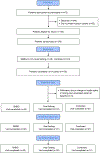Advancing diabetes management in adolescents: Comparative effectiveness of mobile self-monitoring blood glucose technology and family-centered goal setting
- PMID: 29504207
- PMCID: PMC6476179
- DOI: 10.1111/pedi.12648
Advancing diabetes management in adolescents: Comparative effectiveness of mobile self-monitoring blood glucose technology and family-centered goal setting
Abstract
Background: As adolescents gain autonomy, it remains important for parents to be involved with diabetes management to avoid deterioration in glycemic control. Technologies for self-monitoring of blood glucose (SMBG) allow for remote monitoring in real-time by parents. This research compared 3 strategies for improving SMBG and diabetes self-care in the short-term. These strategies were: (1) health information technology (HIT)-enhanced blood glucose meter that shared blood glucose data among patients, their parent, and care providers, and allowed for text messaging; (2) family-centered goal setting; and (3) a combination of (1) and (2).
Methods: One hundred twenty-eight participants enrolled; 97 adolescent-parent pairs attended clinic at 3-month intervals during the 6-month intervention. Differences between treatment groups were evaluated using analysis of variance (ANOVAs) for continuous variables and χ2 tests for frequencies. Within patient changes were evaluated using paired t tests.
Results: Participants in the HIT-enhanced SMBG group had no change in mean glycosylated hemoglobin (HbA1c). Participants assigned to family-centered goal setting had a non-significant decrease in HbA1c of -0.3% (P = .26) from baseline to 6 months. Participants in the combined approach had a significant decrease in HbA1c of -0.6% (P = .02) from baseline to 3 months, but the decrease of -0.4% at 6 months was non-significant (P = .51). The change in HbA1c from baseline to 3 months was greater for the combined approach than for the HIT-enhanced SMBG (P = .05) or family-centered goal setting (P = .01).
Conclusions: Our data suggest that utilizing the family-centered goal setting strategy when implementing HIT-enhanced diabetes technology deserves further study.
Keywords: adherence; blood glucose self-monitoring; patient-centered care; self-care; type 1 diabetes mellitus.
© 2018 John Wiley & Sons A/S. Published by John Wiley & Sons Ltd.
Figures
Similar articles
-
Overcoming Clinical Inertia: A Randomized Clinical Trial of a Telehealth Remote Monitoring Intervention Using Paired Glucose Testing in Adults With Type 2 Diabetes.J Med Internet Res. 2015 Jul 21;17(7):e178. doi: 10.2196/jmir.4112. J Med Internet Res. 2015. PMID: 26199142 Free PMC article. Clinical Trial.
-
A person-centered education for adolescents with type 1 diabetes-A randomized controlled trial.Pediatr Diabetes. 2019 Nov;20(7):986-996. doi: 10.1111/pedi.12888. Epub 2019 Jul 18. Pediatr Diabetes. 2019. PMID: 31268224 Clinical Trial.
-
Effects of mobile phone application combined with or without self-monitoring of blood glucose on glycemic control in patients with diabetes: A randomized controlled trial.J Diabetes Investig. 2019 Sep;10(5):1365-1371. doi: 10.1111/jdi.13031. Epub 2019 Mar 19. J Diabetes Investig. 2019. PMID: 30815973 Free PMC article. Clinical Trial.
-
Value and utility of self-monitoring of blood glucose in non-insulin-treated patients with type 2 diabetes mellitus.Postgrad Med. 2013 May;125(3):191-204. doi: 10.3810/pgm.2013.05.2668. Postgrad Med. 2013. PMID: 23748520 Review.
-
Monitoring glycemic control: the importance of self-monitoring of blood glucose.Am J Med. 2005 Sep;118(Suppl 9A):12S-19S. doi: 10.1016/j.amjmed.2005.07.052. Am J Med. 2005. PMID: 16224938 Review.
Cited by
-
Characterization of youth goal setting in the self-management of type 1 diabetes and associations with HbA1c: The Flexible Lifestyle Empowering Change trial.Pediatr Diabetes. 2020 Nov;21(7):1343-1352. doi: 10.1111/pedi.13099. Epub 2020 Sep 1. Pediatr Diabetes. 2020. PMID: 32741045 Free PMC article.
-
The Quality of Family Relationships, Diabetes Self-Care, and Health Outcomes in Older Adults.Diabetes Spectr. 2019 May;32(2):132-138. doi: 10.2337/ds18-0039. Diabetes Spectr. 2019. PMID: 31168284 Free PMC article.
-
Benefits, implementation and sustainability of innovative paediatric models of care for children with type 1 diabetes: a systematic review.BMC Pediatr. 2024 Aug 5;24(1):502. doi: 10.1186/s12887-024-04945-2. BMC Pediatr. 2024. PMID: 39103837 Free PMC article.
-
Long-term effects of non-pharmacological interventions in adolescents and young adults with type 1 diabetes: A systematic review and meta-analysis.Worldviews Evid Based Nurs. 2024 Dec;21(6):665-677. doi: 10.1111/wvn.12751. Epub 2024 Nov 4. Worldviews Evid Based Nurs. 2024. PMID: 39497508 Free PMC article.
-
Patient and Parent Well-Being and Satisfaction With Diabetes Care During a Comparative Trial of Mobile Self-Monitoring Blood Glucose Technology and Family-Centered Goal Setting.Front Clin Diabetes Healthc. 2022 May 6;3:769116. doi: 10.3389/fcdhc.2022.769116. eCollection 2022. Front Clin Diabetes Healthc. 2022. PMID: 36992766 Free PMC article.
References
-
- Ingerski LM, Anderson BJ, Dolan LM, & Hood KK (2010) Blood glucose monitoring and glycemic control in adolescence: contribution of diabetes-specific responsibility and family conflict. The Journal of adolescent health : official publication of the Society for Adolescent Medicine 47(2):191–197. - PMC - PubMed
Publication types
MeSH terms
Substances
Grants and funding
LinkOut - more resources
Full Text Sources
Other Literature Sources
Medical
Research Materials



